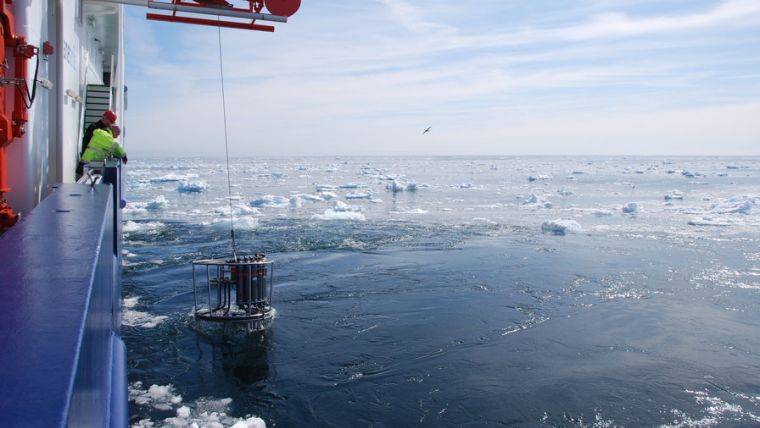Close Connection between Deep Currents and Climate
The Labrador Sea in the northwestern Atlantic is one of the key regions of the global ocean circulation. The GEOMAR Helmholtz Centre for Ocean Research Kiel, Germany, has been operating an array of oceanographic observatories there since 1997. It monitors the currents from the surface to the seabed. In the 'Journal of Geophysical Research Oceans', GEOMAR oceanographers recently published an analysis of their data obtained from 1997 to 2014. It shows a close connection between deep currents and climate variabilities on different time scales.
Mild winters in northern Europe, rainfall in western Africa, hurricanes in North America –the energy transported around the world by the global ocean circulation affects the climate as well as regional weather phenomena. One of the key regions for the ocean circulation is the Labrador Sea between North America and Greenland. There warm, saline waters coming from the south near the sea surface cool down and sink to the depth. There the water masses flow back to the south along the continental margin. Thereby the area is one of the regions of crucial importance for the global ocean circulation.
Oceanographic Observatories at the Southern Exit
At the southern exit of the Labrador Sea, the GEOMAR Helmholtz Center for Ocean Research Kiel has been operating oceanographic observatories since 1997 that cover all levels of this current system. A team of four oceanographers has published an analysis of these data in the Journal of Geophysical Research Oceans.
GEOMAR’s oceanographic observatories are located at 53° North on the western boundary of the Labrador Sea. They consist of a series of current meters and sensors for temperature and salinity attached to chains and steel cables. Anchor weights at the lower end hold these so-called moorings in place while buoyant floatation pull the other end towards the surface. Currents can be measured from just below the surface to just above the ground, according to lead author Rainer Zantopp. In addition, the study is based on data collected by the researchers during a total of 13 scientific cruises in the area between 1996 and 2014, mainly with the German research vessels Meteor and Maria S. Merian, as well as with the French research vessel Thalassa.
Current Fluctuations
The analysis showed that the southward deep currents along the western boundary of the Atlantic have fluctuations on different time scales. The authors were especially surprised by the deepest current near the ocean floor. Although it is more steady than those at the upper levels, it varies with an almost ten-year period.
Further analysis showed that the fluctuations of the deepest flow are synchronous with those of wind systems over the North Atlantic which are influenced by the pressure difference between the Azores high and the Iceland low. The indicator is called the North Atlantic Oscillation (NAO). The intensity of the deepest southward current from the Labrador Sea shows similar fluctuations as the NAO, according to Rainer Zantopp.

Value staying current with hydrography?
Stay on the map with our expertly curated newsletters.
We provide educational insights, industry updates, and inspiring stories from the world of hydrography to help you learn, grow, and navigate your field with confidence. Don't miss out - subscribe today and ensure you're always informed, educated, and inspired by the latest in hydrographic technology and research.
Choose your newsletter(s)
























